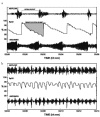The Ignored Parameter in the Diagnosis of Obstructive Sleep Apnea Syndrome: The Oxygen Desaturation Index
- PMID: 29988275
- PMCID: PMC6017211
- DOI: 10.5152/tao.2018.3025
The Ignored Parameter in the Diagnosis of Obstructive Sleep Apnea Syndrome: The Oxygen Desaturation Index
Abstract
Objective: The apnea-hypopnea index (AHI) does not provide information about the apnea depth and length. We aimed to evaluate the correlation of the oxygen desaturation index (ODI) with AHI and the subjective symptoms because it is known that hypoxia plays an important role in morbidity and complications of obstructive sleep apnea syndrome (OSAS).
Methods: We reviewed the data of patients who applied to our clinic between 2010 and 2014 and underwent polysomnography (PSG) with a diagnosis of suspected sleep apnea. The demographic and anthropometric data of the patients were recorded. Epworth sleepiness scale (ESS) and values of AHI and ODI were analyzed in PSG.
Results: A total of 321 patients were divided into four groups, according to AHI as follows: 82 (25.5%) common snoring, 77 (24%) mild obstructive sleep apnea (OSA), 71 (22.1%) moderate OSA, and 91 (28.3%) severe OSA. A strong correlation was detected between AHI and ODI (p<0.005 and r=0.904) in all patient groups. There was a positive correlation between AHI and ESS (p<0.05 and r=0.435), but the correlation of ESS with ODI was stronger than that with AHI (p<0.05 and r=0.504).
Conclusion: The subjective symptoms of sleep apnea syndrome seem to be closely related to oxygen desaturations. Hypoxia during apnea periods of OSA is important; therefore, we suggest that ODI is as valuable as AHI in diagnosing and grading the OSAS.
Keywords: Epworth sleepiness scale; Obstructive sleep apnea; apnea-hypopnea index; oxygen desaturation index; polysomnography.
Conflict of interest statement
Conflict of Interest: No conflict of interest was declared by the authors.
Figures


References
-
- Zhan G, Fenik P, Pratico D, Veasey SC. Inducible nitric oxide synthase in long-term intermittent hypoxia: hypersomnolence and brain injury. Am J Respir Crit Care Med. 2005;171:1414–20. https://doi.org/10.1164/rccm.200411-1564OC. - DOI - PMC - PubMed
-
- Konecny T, Kara T, Somers VK. Obstructive sleep apnea and hypertension - an Update. Hypertension. 2014;63:203–9. https://doi.org/10.1161/HYPERTENSIONAHA.113.00613. - DOI - PMC - PubMed
-
- Kulkas A, Tiihonen P, Julkunen P, Mervaala E, Töyräs J. Novel parameters indicate significant differences in severity of obstructive sleep apnea with patients having similar apnea-hypopnea index. Med Biol Eng Comput. 2013;51:697–708. https://doi.org/10.1007/s11517-013-1039-4. - DOI - PubMed
-
- Mediano O, Barceló A, de la Pe-a M, Gozal D, Agustí A, Barbé F. Daytime sleepiness and polysomnographic variables in sleep apnoea patients. Eur Respir J. 2007;30:110–3. https://doi.org/10.1183/09031936.00009506. - DOI - PubMed
LinkOut - more resources
Full Text Sources
Other Literature Sources
Medical
